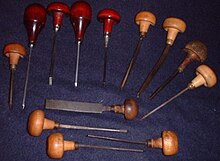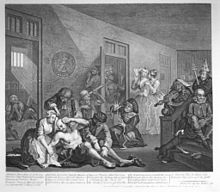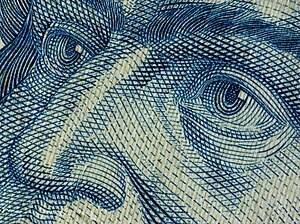Burin engraving
The burin engraving or sweet carving is a set of printing and stamping techniques in which the image is engraved by making an incision (or " is chiseled") into a surface and the line thus incised or sunken area contains the ink. It is the opposite technique of relief printing, in which the parts of the matrix that form the image protrude from the main surface.
Normally, sheets of copper or, in recent times, zinc, called plates or plates, are used as the surface or matrix, and the incisions are created by etching, engraving, drypoint, aquatint, or halftone, often in combination. Colographs can also be printed as chisel plates.
Following the decline of woodcut, which was the main relief technique, around 1550, burin engraving techniques dominated both fine printmaking and most popular types of illustration and prints until the middle of the century XIX.
Process
The burin engraving or sweet carving is a rotogravure technique in which one draws on a metal plate excavating lines on a matrix using exclusively the burin; tool composed of a handle at the end of which an elongated piece of metal has been attached, in the shape of a cylinder to which two faces have been excavated that are cut at one edge and have been sharpened in a bevel. More than a technique, it is a way of understanding chalcographic engraving, typical of the 17th and 18th centuries in Europe.
The burin resembles a plow in its shape, and the engraver uses it in a similar way; making grooves on the plate, so that the greater the pressure it exerts, it manages to make a deeper incision on it, which will cause a greater amount of ink to lodge later. The grooves produced by the burin will retain the ink that will later pass to the paper when impressed on the press or press.
It differs from drypoint in that what retains the ink is a groove, not a burr as in the case of drypoint, so the iron lasts longer. In addition, the qualities it produces are different, the lines are sharper and more modulated.
It starts with an etching engraving, later tinting it with a burin to obtain tones with exquisite modulations, influencing more or less deeply on the etching lines. It is an extremely laborious technique, which requires perfect planning and a long trade to obtain professional results.
The prints made according to the sweet carving have a characteristic appearance, which largely comes from the more or less orthodox use of the theory of strokes, which allowed each shade of gray in a drawing or each color in a painting to be translated copied with astonishing delicacy by crossing lines at standard angles. Among the engravings made by the professional workshops of that time, the copies of paintings from collections stand out above all, such as the magnificent copies of Velázquez that can be found in the National Chalcography of Spain.
You can recognize a sweet-cut engraving by its typical rhombus texture, a neat and worked appearance, and by the modulation of the strokes when viewing the print greatly enlarged.
Today this technique has fallen into disuse, although at least its graphic aspect is used to make the originals of banknotes, in which the drawings are made from thousands of crossed lines and with modulated thicknesses.
Contenido relacionado
Gothic metal
Quake II
The Fura dels Baus




